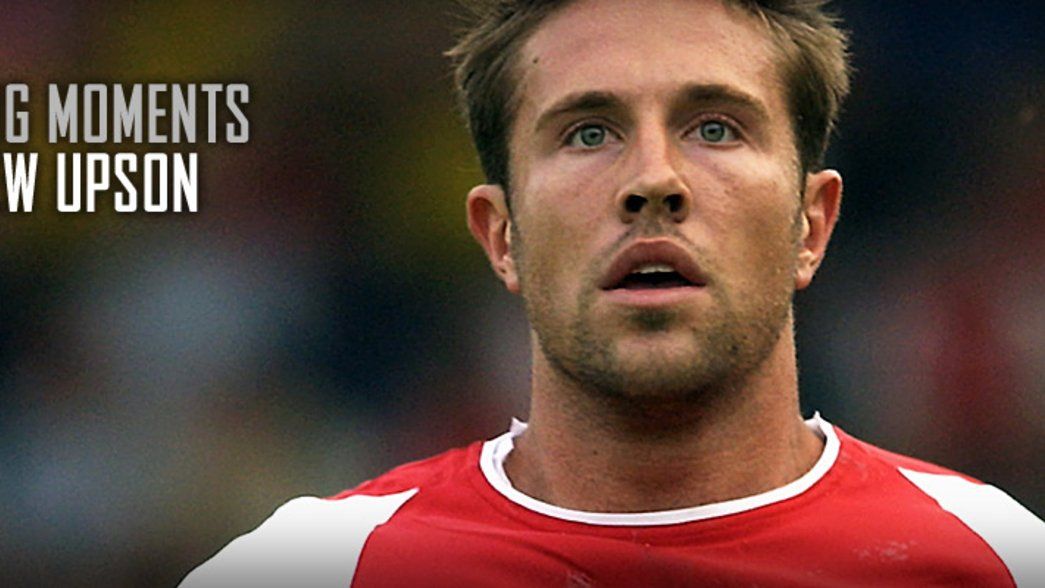In 'Defining Moments', former Arsenal stars select the situations that defined their career with the Gunners.
This is a running feature and first appeared in the matchday programme.
Matt Upson is next to recall his favourite memories.
WELCOME TO LONDON COLNEY
For me, my first big defining moment at the club was my first day at training.
I was put in a small group to do some running. The other players in my little group were Marc Overmars, Tony Adams and Dennis Bergkamp. I was 18.
That was a nice introduction!
It had been a strange process getting there, to be honest. I was a young lad at Luton Town, playing in their reserves and in the FA Youth Cup but there was already interest in me. I was seen as a player with great promise.
Newcastle United wanted me. Kenny Dalglish was calling me. I had no agent then. I was just sort of left to get on with it. A fee had been agreed with Newcastle as it had with Arsenal. The condition was I would go to speak to Arsène Wenger, so I went to the training ground to meet him and I signed pretty quickly.
I didn’t even go to Newcastle to hear what Kenny had to say. It was a gigantic leap, moving from Luton Town (reserves) to Arsenal, who were, at the time, the best team in the country, certainly on a par with Manchester United.
But Arsenal made it so easy for me. I just fitted in. There was a really high level of player at the club at the time, and I admit when I first got there that first day I thought “Where am I?” It was bizarre. But it also became very normal, very quickly.
INJURY AT LEICESTER
Rupturing my cruciate at Leicester during Christmas 1999 set the tone for my Arsenal career. At the time, I was making great headway in the team and that was no mean feat as I had the likes of Tony Adams and Martin Keown competing for those central defensive places.
I remember it well because I thought I was ok. I had caught my studs in the turf as I went in for a challenge with Emile Heskey. It kind of went pop – if you’ve ever had a cruciate injury you will know that sound – and I came off. But within seconds I said to the physio Gary Lewin: “I’m OK to go back on.” And I really believed that because I was not in much pain and felt like I could run. Gary, of course, knew better and told me there was no way I could play. Then I tried to walk and it all felt very loose.
The surgery back in those days was nowhere near as advanced as it is today. On top of that, my body was still developing. I went on a short holiday to clear my head, had the surgery and then it was rehab, and lots of it. I had a lot of issues during my rehab which I don’t think would happen if the injury occurred today. It took me about 12 months to get back my fitness.
TEAM PLAYER
There was a period, long after that injury against Leicester, when I really felt I belonged. For me, nudging Martin Keown out of the team was a key moment during my time at the club. OK, so I know he was 34 or 35 at the time, but Martin was an exceptional defender and it was a big deal for me. I had been sat behind him for a few years watching him, learning, listening to him. He was my roommate, we were actually pretty close mates, and he was a great help to me.
But I was also competition – and Martin thrived on that competition. In fact, the whole club was built on it. You could not rest on your laurels. There was quality throughout the squad. Players were hungry to do well and earn a place in the team.
I remember at the time Stuart Taylor was also having a run in the team. And yes, this was a real defining time for me during my Arsenal career because I had so much belief. I had worked hard to get this point. In the end, more injuries came my way in my career, such as a broken leg. Martin also worked hard to get back. I had soon relinquished my position in the team.
LEAVING
I look back on my time at Arsenal as a great education. And what an education.
It was like doing the best university degree in football. I had been there for around five and a half years but I had more than my share of injuries and at times had been out on loan.
I had played with some great, great players. I’d been there when we won the ‘double’ and I won a title medal in 2002. At the time, when I got injuries, it didn’t affect me so much, but now, with my career over, I look back and reflect and it hurts that I didn’t play as much as I would have hoped.
Arsenal had been a big journey for me – and one I needed to go on. But I went to speak to the boss and tell him I felt I should go. He didn’t want to sell me and I could have stayed, but I just felt my time had come to move. If I’m being honest, I also think the boss had lost a little faith in me. He had tried other centre halves like Igors Stepanvos and Pascal Cygan so it felt even more to me that the time had come to move.
Birmingham were the only club I spoke to and I signed for them. I played a lot of Premier League football at St Andrew’s – there was no safety net, I had to stand on my
own two feet there. Arsenal had clearly brought my potential back in 1997 and I did not properly fulfil it because, as I say, of those injuries. I also broke my leg and spent another long period on the sidelines.
I have spoken with Arsène Wenger since – he would come to the training ground when England trained there – and we have spoken about my time at Arsenal.
I’m honest in that I did not perform as much as I liked, but I still loved those years at Highbury.
Copyright 2025 The Arsenal Football Club Limited. Permission to use quotations from this article is granted subject to appropriate credit being given to www.arsenal.com as the source.




